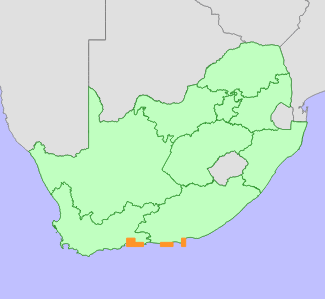|
Scientific Name | Satyrium princeps Bolus |
Higher Classification | Monocotyledons |
Family | ORCHIDACEAE |
Common Names | Coastal Satyr (e) |
National Status |
Status and Criteria | Vulnerable C2a(i) |
Assessment Date | 2011/09/14 |
Assessor(s) | L. von Staden, W.R. Liltved, E.G.H. Oliver & T.A. Oliver |
Justification | EOO 11 072 km², at least 50% of this formerly common species' habitat has been lost to coastal development, agriculture and alien invasive plants, however, the decline has happened over a period longer than 10 years or three generations (generation length is probably ± five years). Recent surveys have recorded seven remaining subpopulations, the largest of which consists of about 450 plants. Surveys have however not yet covered the full known range of the species, and it is suspected that at least seven to 10 more subpopulations remain, and that the total population size is between 1 000 and 4 500 mature individuals. Population decline due to ongoing habitat loss is continuing. |
Distribution |
Endemism | South African endemic |
Provincial distribution | Eastern Cape, Western Cape |
Range | Wilderness to Port Alfred. |
Habitat and Ecology |
Major system | Terrestrial |
Major habitats | Garden Route Granite Fynbos, St Francis Dune Thicket, Goukamma Dune Thicket |
Description | Among bushes in open places on fixed dunes close to the shoreline, 0-150 m. |
Threats |
| Habitat destruction has caused a 50% reduction in the EOO of this species. Remaining subpopulations are confined to small fragments and road verges, and continue to decline due to ongoing habitat loss to coastal development around Wilderness, Knysna and Cape St. Francis. It is also threatened by Acacia cyclops invasion on the coastal flats south of Humansdorp. |
Population |
This species was once quite common, but the population has been much reduced by habitat loss. Remaining subpopulations tend to be small and confined to small fragments of natural vegetation. Recent surveys by volunteers of the Custodians of Rare and Endangered Wildflowers (CREW) programme have recorded a number of previously unknown subpopulations between Sedgefield and Port Elizabeth. The largest subpopulation occurs in the Goukamma Nature Reserve, where there are about 450 plants in scattered clumps. Another large subpopulation near Port Elizabeth consists of at least 100 plants, however, surveys of five other subpopulations recorded less than 50 plants per subpopulation.
Although this species is reported in the literature to also occur between Port Elizabeth and Port Alfred, there are no recent records from this area, and the status and population trend in this area is not known. There are currently seven known remaining subpopulations, but it is suspected that a number of other subpopulations remain, and continued surveys are needed.
|
Population trend | Decreasing |
Conservation |
| Goukamma Nature Reserve and Cape Recife Nature Reserve. |
Notes |
| Pollinated by Lesser Double-collared Sunbird. Flowering is not fire dependent, but plants do appear to flower best in open places such as along pathways, and have also been found in disturbed areas, or sites that are mowed regularly. |
Assessment History |
Taxon assessed |
Status and Criteria |
Citation/Red List version | | Satyrium princeps Bolus | VU B1ab(i,ii,iii,iv,v) | Raimondo et al. (2009) | | Satyrium princeps Bolus | Lower Risk - Near Threatened | Victor (2002) | | Satyrium princeps Bolus | Vulnerable | Hilton-Taylor (1996) | |
Bibliography |
Goldblatt, P. and Manning, J.C. 2000. Cape Plants: A conspectus of the Cape Flora of South Africa. Strelitzia 9. National Botanical Institute, Cape Town.
Hall, A.V. 1981. Satyrium princeps. Flowering Plants of Africa 46:t.1827.
Hall, A.V. 1982. A revision of the southern African species of Satyrium. Contributions from the Bolus Herbarium 10:1-142.
Hall, A.V. 1999. Satyrium. In: H.P. Linder and H. Kurzweil (eds.), Orchids of southern Africa (pp. 152-181), A.A. Balkema, Rotterdam.
Hilton-Taylor, C. 1996. Red data list of southern African plants. Strelitzia 4. South African National Botanical Institute, Pretoria.
Liltved, W.R. and Johnson, S.D. Unpublished. The Cape Orchids - Wild orchids of the Cape Floral Kingdom.
Linder, H.P. and Kurzweil, H. 1999. Orchids of southern Africa. A.A. Balkema, Rotterdam.
Raimondo, D., von Staden, L., Foden, W., Victor, J.E., Helme, N.A., Turner, R.C., Kamundi, D.A. and Manyama, P.A. 2009. Red List of South African Plants. Strelitzia 25. South African National Biodiversity Institute, Pretoria.
Victor, J.E. 2002. South Africa. In: J.S. Golding (ed), Southern African plant Red Data Lists. Southern African Botanical Diversity Network Report 14 (pp. 93-120), SABONET, Pretoria.
|
Citation |
| von Staden, L., Liltved, W.R., Oliver, E.G.H. & Oliver, T.A. 2011. Satyrium princeps Bolus. National Assessment: Red List of South African Plants version 2024.1. Accessed on 2025/12/02 |
 Comment on this assessment
Comment on this assessment

